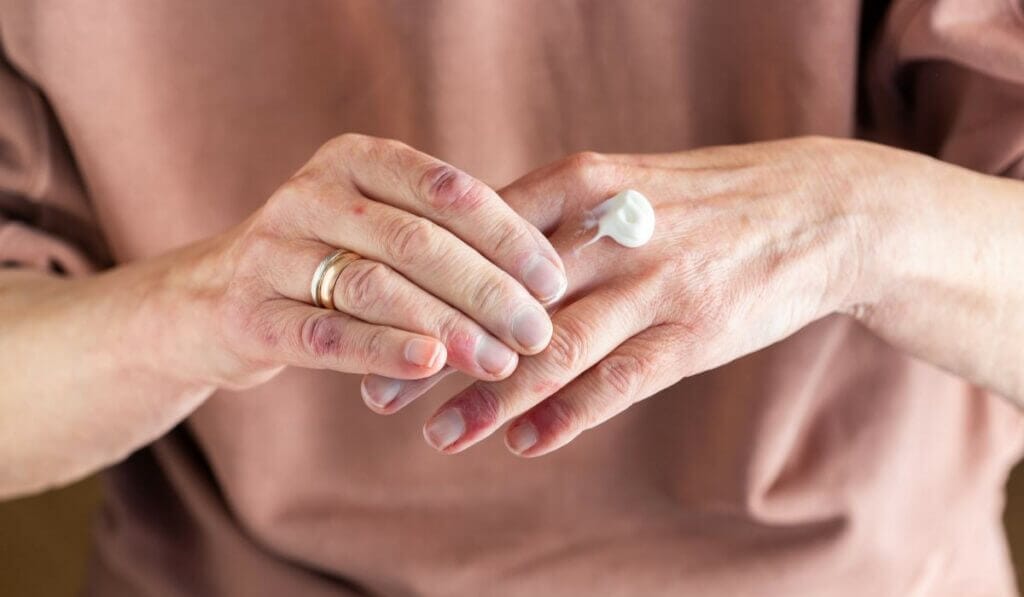
Eczema sufferers are all too familiar with the itchy misery and sleepless nights the skin disorder can cause. New guidelines are clearing up the best options for finding relief – and which are best avoided.
A panel of experts reviewed reams of evidence on a range of eczema treatments – from the latest medications to bleach baths and ultraviolet phototherapy – to develop the 2023 Atopic Dermatitis Guidelines. They’re meant for physicians to use in their practices when treating eczema.
“Finally, we have a guideline that is trustworthy, driven by credible information, and systematically reviewed to address all available evidence,” says Dr. Derek Chu, director of the Evidence in Allergy Research Group at McMaster University in Ontario, Canada. Chu co-chaired the Joint Task Force on Practice Parameters, which wrote the guidelines.
The new guidelines differ from a past version published over a decade ago in that they considered the cost of treatments, accessibility, and patient preferences, along with the scientific evidence, Chu adds.
Highlights of the Eczema Guidelines
Skip prescription moisturizers.
Fragrance-free moisturizers remain the first-line treatment for eczema. But there’s little need to fork out money for a prescription cream. Some evidence suggests that prescription moisturizers may do a bit better in reducing symptoms and flares. But they can be costly. Over-the-counter moisturizers are fine, the eczema guidelines say.
Topical corticosteroids, the go-to.
Corticosteroid creams are still the go-to treatment for eczema that isn’t controlled by moisturizers alone. They come in a variety of potencies. Just avoid using high potency steroids for continuous, prolonged periods (greater than four weeks without a break).
Also, limit the use on sensitive areas such as the face, skin folds and groin. These areas are more prone to rare cases of skin thinning or other skin changes due to long-term topical steroid use.
Topical calcineurin inhibitors strongly endorsed.
To control eczema and to prevent flares, the guidelines strongly endorse topical calcineurin inhibitors, or TCIs. TCIs include pimecrolimus cream (the brand Elidel) and tacrolimus ointment (the brand Protopic).
The Food and Drug Administration approved these medications back in 2000 and 2001. But in 2006, many patients got scared off after the FDA required a “black box” warning about possible cancer risk. The warning related to rare reports of skin cancer and lymphoma, Chu says. Turns out, the heightened risk was showing up mainly in mice and in people who had suppressed immune systems due to organ transplants and were taking TCIs orally.
More recent research shows the boxed warning was likely unnecessary. A 2023 review and meta-analysis by Chu and colleagues of 110 studies on TCIs found no added risk of cancer. His analysis included 52 controlled trials, the gold standard of research, and a combined 3.4 million patients, of all ages. “We found no credible increase … and if there is any increase, it is exceptionally marginal,” Chu says.
The warning label is still on the medications in the U.S.; it no longer appears in Canada.
A physician will prescribe using pimecrolimus or tacrolimus once or twice a day. The medication can be combined with a topical corticosteroid, or used instead of a steroid. Some may prefer a TCI for the face, eyelids, or skin folds, since TCIs don’t have the potential for skin thinning.
Pimecrolimus is for mild to moderate eczema, while tacrolimus is for moderate to severe.
TCIs can be quite effective to gain and maintain control of eczema, Chu says. “Once you gain control, to prevent the next flare, you have the option of using a little topical corticosteroid, 2 to 3 times a week, or using a topical calcineurin inhibitor.”
Topical: crisaborole and JAK inhibitors.
Among newer topical cream treatments, the task force recommends crisaborole (Eucrisa) for mild to moderate eczema. Crisaborole can be a good option for patients who really value a non-steroidal treatment.
But the task force doesn’t recommend ruxolitinib (the brand Opzelura). There was a lot of excitement in 2022, when the FDA approved ruxolitinib for mild to moderate eczema in adolescents and adults. It was the first in a new class of eczema medications called Janus kinase (JAK) inhibitors. (Since then, two pill-form JAK inhibitors for more severe eczema have been approved in the U.S. and Canada).
The studies on topical JAK inhibitors were done in adolescent and adult patients with “very, very mild eczema,” covering about 10 percent of their body,” Chu says.
He agrees “they could be effective.” But when all current evidence is considered, “you actually find out the effect of the topical JAKs shake out to be more modest than many other treatments, like potent topical corticosteroids or potent topical calcineurin inhibitors.”
Another consideration: The FDA has placed a boxed warning on all JAK inhibitors. This came after a controlled trial in rheumatoid arthritis patients found a heightened risk of cancer, infection, and blood clots in those taking a different JAK inhibitor, tofacitinib, as a pill.
Oral medications deliver a higher dose than skin creams, Chu says. But given the lack of long-term studies ruling out potential risks, the task force came down on the side of caution with JAK inhibitor cream.
Skip the elimination diet.

Elimination diets remove certain foods from the diet, often dairy, egg, gluten, or soy, typically for a month or more, to see if eczema improves. But the data doesn’t back this up as effective – and there can be consequences.
Eating foods helps build, and potentially maintain, tolerance, Chu explains. Not eating them could promote the development of food allergies, especially in infants and children. And children with atopic dermatitis are already at a higher risk of food allergies.
Plus, an analysis of studies on elimination diets for eczema concluded they had “little to no benefit.”
If patients are determined to try an elimination diet, Chu recommends removing the food for no more than a week. Then put it back in the diet, and remove it again for a week. You can try this a few times. Physicians and patients should carefully check the skin before and after each cycle. “Chances are, they will not find any pattern,” he says.
When to try oral medications.
If the topical treatments aren’t providing enough relief for a patient’s moderate to severe eczema, oral therapies may be called for. These are powerful medications proven to bring relief to people who have suffered for years with severe eczema.
The first drugs your physician may recommend are the biologics, dupilimab and tralokinumab. Dupilumab is approved for moderate to severe eczema in adults and children ages 6 months and older; tralokinumab is for 12 years and up.
If those don’t work or you’re having side effects, a next step would be to try an oral JAK inhibitor. Upadacitinib (the brand Rinvoq) is approved for ages 12 and up. Abrocitinib (the brand Cibinqo) is approved for adults in the U.S. and ages 12 and older in Canada.
Patients need to balance the upsides with the potential risks, “although the early available non-randomized data in AD [atopic dermatitis] are so far reassuring,” the eczema guidelines state.
Having concerns about the adverse events in arthritis patients taking JAK inhibitors [see ‘Topicals’ above]? Chu says an option is to choose a short course of a JAK inhibitor to treat bad flares or before a special life event, like a wedding.
One treatment that the experts recommend avoiding – steroid pills. The reason: skin improvements from oral steroids are short-lived, and symptoms return soon after the steroids are halted. Oral steroids can also have side effects.
Bleach baths: mixed benefits.
In the previous 2012 guidelines, twice-weekly, diluted bleach baths were recommended to reduce eczema severity and skin infections.
That’s changed in the new guidelines. Now, bleach baths are only recommended for those with moderate to severe eczema, but not for mild eczema.
Studies show that diluted bleach baths may reduce eczema symptoms, but not in all patients. A meta-analysis of 10 controlled trials found 32 percent of those using bleach baths saw significant improvement in their eczema symptoms. That compared to 22 percent in the control group taking ordinary baths.
If you’re going to try it, bleach baths should be done twice a week, using ¼ to ½ cup of household bleach in a tub of water. You need to avoid getting bleach in the eyes, make sure the room is well-ventilated, soak for 10 minutes or so, be careful not to stain clothes or other surfaces, and moisturize well afterward. The routine, Chu says, “is a burden.”
Patient input showed that those with moderate to severe eczema felt the chance of even small improvements in eczema symptoms made beach baths worth trying. However, people with mild eczema likely wouldn’t see enough benefit to make the regimen worth the trouble.
Ultraviolet phototherapy may help.
People with moderate to severe eczema who aren’t doing well on the biologics, or who don’t want to take another oral medication for reasons such as pregnancy, could try narrow band ultraviolet B (NB-UVB) light.
The treatment is time-consuming – you typically have to go to a doctor’s office three times a week to receive it, for months at a time. Unfortunately, there isn’t good evidence for the safety or efficacy of home devices.
The task force is a joint project of the American College of Allergy, Asthma & Immunology and the American Academy of Allergy, Asthma & Immunology. See the full guidelines here.
Related Reading:
Dupilumab in Adolescents with Eczema Called ‘Life-Changing’
Topical Steroid Overuse Caused My Eczema to Spread, What to Do?
Staph Infection in Eczema Emerges as Food Allergy Risk Factor





